Edie Melson's Blog, page 37
October 8, 2024
Three of the Most Important Things for New Writers to Know
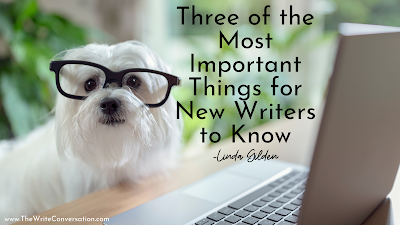
by Linda Gilden @LindaGilden
As new writers one of the first things we learn is there is so much to learn we couldn’t possibly put it in a few pages. However, I thought it might help to know a few of the most important things to find out as you start writing. I thought if we started with three of the most important things that would at least get us started.
Three Important Things for Every New Writer to Know
1. Know your audience.
When I started writing. I learned a very valuable lesson at my first writers conference, and it has served me well for over four decades.
At this conference, we were invited as part of our tuition to submit one article for a publisher or editor to look at and make suggestions on how to improve it. Before that conference, I had spent time at our lake house, sitting on the bank and watching our son skipping stones across the water. He was very good at it and as I watched, my mind filled with related analogies. I decided to write an article about the experience and how encouraging it was to me to sit and watch my son skip stones. That was the article I submitted.
When I met with the editor, the first thing he said to me was not, “Oh, you are such a good writer. I’d really like to buy your article.” Nor was it “This is the best article I’ve ever read.” He simply said with a sigh, “I used to skip stones when I was a little boy.”
What was the lesson I learned? His words indicated to me that it was not so much the writing, but it was the emotion that accompanied it that he based his comments on. I had sparked a happy memory in his mind and connected to his heart.
What was the lesson for me in that? Who knows the publication’s audience better than the editor. To connect with the publication’s audience, you must connect with the heart of the editor first. When you do that, you know that you have hit the bull’s eye of the publication’s audience.
2. Not everyone is going to like your work.
When you begin to submit to publishers and periodicals, you won’t always get an acceptance letter. Sometimes you’ll get a rejection. I’ve heard many experienced writers say, “Just don’t look at it as a rejection. Consider it a ‘no thank you.’”
Many times, the “no thank you” is a creative way of saying we can’t use this right now. It may be they have published something similar recently. Or it could be they don’t have room for it on their editorial calendar. It doesn’t mean the editors don’t like your work, particularly if they end their letters with statements like “Please send us more of your work.” It does not fit our current needs.” “Great writing but we don’t publish anything on that subject. Please check our guidelines for subjects we are looking for.”
Following the publishing guidelines will give you the greatest opportunity for acceptance of almost anything else. If you know you have given a publisher just what they have asked for, you at least know your format is correct and you have given them what they are looking for.
3. Perseverance is key.
No one who cares as much as you do that you succeed. Therefore, it is up to you to work as hard as you can to become the best writer you can be. Learn everything you can about writing. Read books, go to conferences, network with every writer you know. Your networking relationships will prove invaluable to your career. When you meet writers who have areas of expertise, especially unlike yours, make notes of the things they are experts in. You may need to call them someday to verify points in your book or article. Make friends with those who are writing in the same genre as you. They will be able to help you learn the genre as well as meet others who are writing what you are. You can share marketing tips and opportunities for publication with each other. Read the market guides for publishers especially looking for specific stories.
Almost every writer you ask will give a different answer to the title question. So don’t stop asking others what you want to know. Most writers love to encourage other writers and help them along in their writing journey. Along with these three things, I would recommend you bathe every part of your writing career with prayer. Only God knows why He has called you to be a writer. But I know that everything He calls us to do, He will equip us to do well. Don’t disappoint Him.
TWEETABLEThree of the Most Important things for New Writers to Know from @LindaGilden on @EdieMelson (Click to Tweet)
 Linda Gilden is an experienced, bestselling writer, speaker, award-winning editor, marketer, and speaking coach, ghostwriter, and writing coach. Author of 40 books and 2,000+ magazine articles, Linda appreciates a great story. She believes with our stories, we can change the world one word at a time and loves to encourage others to do that through writing coaching and personal tutoring. Her newest book was released in November: TRADING SHADOWS: EXCHANGING A LIFE OF SECRETS, FEAR, AND DOUBT FOR A LIFE OF FREEDOM WITH THE ALMIGHTY.
Linda Gilden is an experienced, bestselling writer, speaker, award-winning editor, marketer, and speaking coach, ghostwriter, and writing coach. Author of 40 books and 2,000+ magazine articles, Linda appreciates a great story. She believes with our stories, we can change the world one word at a time and loves to encourage others to do that through writing coaching and personal tutoring. Her newest book was released in November: TRADING SHADOWS: EXCHANGING A LIFE OF SECRETS, FEAR, AND DOUBT FOR A LIFE OF FREEDOM WITH THE ALMIGHTY.
Published on October 08, 2024 22:00
October 7, 2024
CoWriting Rules to Make Writing with Others Easier

by Cindy K. Sproles @CindyDevoted
Cowriting sounds like such fun and it indeed can be. But there are things to consider before you enter into the cowriting world. You've heard the adage, "Never lend money to a friend," and co-writing can be similar. Here's why we have the adage about lending money. When we lend money, we expect repayment, and often, that doesn't happen, or if it does, it happens slowly. Friendships are lost over less.
Choosing to join a like-minded friend in a writing adventure can be a wonderful experience, but there are things you should know before entering this "marriage" of words. Every writer has expectations for their work, and your expectations must be placed on the table before you begin. Cowriting is a give-and-take thing, and setting the boundaries of expectation is vital.
CoWriting Tips for Writers
Realize your writing styles may differ: It's important to note that every writer has their style, and when we enter into a cowriting project, it's vital to chat in advance and draw a line in the sand. Cowriting is a joint effort where two different styles must come together and meet on common ground. Most publishers have a style sheet that is sent to every author upon being assigned to an editor. These guidelines help the writer remain consistent with how the publisher wants their products to look. Take time and make a style sheet of sorts. Decide who will write what and who will take the lead. Will you write alternating chapters or split a chapter? Decide on a format and an expected deadline for each other. In other words, you will submit your work on chapter one by _____, and it's done as expected.
When things jump track, discuss it: We all know that a project can begin with one intent, and there's an unexpected curve midway through. The wonderful thing about curves is they route us in new ways. However, when you are cowriting, it's best to voice those curves when you see the sign. Not after the fact. Why? Common courtesy. We spoke earlier that everyone has their own style, and while some can jump the track easily, others cannot. In non-fiction, this is especially important since there is something you may be working to achieve with teaching. A rabbit trail can throw everything off. Curves can be a lot of fun in fiction, interjecting incredible twists to our plot, but common courtesy is important. Still, be courteous.
Cowriting is a give-and-take: Writers can be very possessive of their work, but when you cowrite, there may be times when some of your writing may not fit. Communication is vital, and what if you hit that spot where you feel your way is the best? Read the work together to find the workaround. You can do this when you realize the project is what is most important. Practice giving and taking and learning the art of working together. You may have to sacrifice something today for something better in the long run.
Stick to the plan: Whether you write fiction or non-fiction, plot and outline the book and then stick to the plan. It's alright to veer from the plan occasionally, but that is not always in the best interests of the work or your partnership. If significant changes arise, discuss and decide what is in the works best for the story or the project's teaching goal. Sometimes, good ideas are spiffy, but they may not work now, but later, it’s the perfect fit.
I co-wrote a book entitled Heart’s Song with Aaron Gansky. The idea and the invite were his so for me, it was easy to take the back seat and let Aaron drive. Our biggest problem was he was on the west coast and I lived on the east. Finding a time that was a middle ground for us both was a challenge. Still, when we wrote, if I saw an opportunity to take things in a different direction, I’d send him a note and say, what about…? Most of the time Aaron was on board. If we hit an idea where he wasn’t, he was sweet enough to explain why it wouldn’t work. We had such a blast writing the book that we turned out a 120K word manuscript in three weeks.
My co-writer and I were great writing partners and that made the experience wonderful. I’ve spoken with others who swear they’d never co-write again. You do have to learn to play well with others. If you decide to embark on a co-writing experience take these four things into account and lay a solid and successful pathway for you both.
TWEETABLECoWriting Rules to Make Writing with Others Easier from @CindyDevoted on @EdieMelson (Click to Tweet)
 Cindy K. Sproles is an author, speaker, and conference teacher. Having served for a number of years as a managing editor for Lighthouse Publishing of the Carolinas and Ironstream Media, Cindy now works as a mentor, coach, and freelance editor. She is the co-founder of Writing Right Author Mentoring Services with Lori Marett and she is the director of the Asheville Christian Writers Conference. Cindy is also the co-founder of Christian Devotions Ministries and WWW.CHRISTIANDEVOTIONS.US, as well as WWW.INSPIREAFIRE.COM. Her devotions are in newspapers and magazines nationwide, and her novels have become award-winning best-selling works. She is a popular speaker at conferences and a natural encourager. Cindy is a mountain girl, born and raised in the Appalachian mountains, where she and her husband still reside. She has raised four sons and now resorts to raising chickens where the pecking order is easier to manage. You can visit Cindy at WWW.CINDYSPROLES.COM or www.wramsforwriters.com.
Cindy K. Sproles is an author, speaker, and conference teacher. Having served for a number of years as a managing editor for Lighthouse Publishing of the Carolinas and Ironstream Media, Cindy now works as a mentor, coach, and freelance editor. She is the co-founder of Writing Right Author Mentoring Services with Lori Marett and she is the director of the Asheville Christian Writers Conference. Cindy is also the co-founder of Christian Devotions Ministries and WWW.CHRISTIANDEVOTIONS.US, as well as WWW.INSPIREAFIRE.COM. Her devotions are in newspapers and magazines nationwide, and her novels have become award-winning best-selling works. She is a popular speaker at conferences and a natural encourager. Cindy is a mountain girl, born and raised in the Appalachian mountains, where she and her husband still reside. She has raised four sons and now resorts to raising chickens where the pecking order is easier to manage. You can visit Cindy at WWW.CINDYSPROLES.COM or www.wramsforwriters.com.
Published on October 07, 2024 22:00
October 6, 2024
10 Ways to Boost Your Blog Visibility Using Pinterest

by Ginny Cruz, MPA, PT
You've written a beautiful blog, but notice in your site's statistics that few people have read it. All that work to compose, edit, and get it online failed to reach your target audience. What's a writer to do? I suggest using Pinterest to find more organic readers.
Pinterest is unlike Facebook and other social media sites. It is not classified as social media. It's a visual search engine. Think of Google with pictures. Users go to Pinterest to find ideas and dream of a better life. One expert on Pinterest marketing said, "Pinterest is about who I want to be." And that's why you want to get your content in front of those people. They may want a better prayer life, book ideas for their grandchildren, or parenting tips. It's more than recipes and to-die-for kitchens.
According to a quick Google search, Pinterest has 450 million monthly users. Sixty-nine percent are female, and the largest audience segment is ages 25–34. The reach is worldwide. Over the past few years, my readers at ginnycruz.comhave come from ninety-two countries. Pinterest has been a driver of much of that traffic.
How to Get Started Increasing Blog Visibility1. Set up a Pinterest account. For authors, I recommend using your name. 2. Use a professional headshot as your profile picture3. Create a header image that tells readers who you are. 4. Use a few descriptors in your profile that describe you. Mine are pediatric physical therapist, author, mom, and I help moms.5. Build a Pinterest pin. Pinterest images are called pins. I use Canva Pro for this, as it has templates. You can also create a pin directly on Pinterest. 6. Use an image related to your blog's content. I use my blog’s featured image. 7. Create a short title and description of your content to tease readers. Use keywords and phrases related to your blog content.8. Add a link to the blog post you are featuring. For example, my Pinterest pin, 7 Ways Screens Harm Your Child, links directly to that post. You want the reader to click on your pin and go directly to the content. They'll move on if they have to click around your website to find it. 9. Share your Pinterest pin on your other social media sites. You'll need to resize it to fit the image parameters of Facebook, Instagram, X, etc. Canva Pro allows you to easily resize them without manually entering new dimensions. 10. You can also make a couple of pins with related images and colors (stay within your brand colors and fonts). Each pin will link back to your blog. When you resize these pins, you've created memes for all your other social media sites without making new ones. For example, you can resize and share one pin on all your other sites. That's a huge time saver.
While most writers dislike marketing their blogs or articles, Pinterest is an easy and fun way to get your God-inspired words to your future readers, no matter where they live. I have readers in communist countries, and God has your readers in hard-to-reach places, as well.
Want more ideas? Look at how DiAnn Mills uses Pinterest to share her writing.
If you use Pinterest, please share your ideas with us.
TWEETABLE10 Ways to Boost Your Blog Visibility Using Pinterest from Ginny Cruz on @EdieMelson (Click to Tweet)
 Ginny Cruz, MPA, PT is a pediatric physical therapist, early intervention specialist, and award-winning author. Her writing encourages and teaches moms simple and effective ways to help their baby meet developmental milestones. In addition to writing, she enjoys hiking, reading, and camping with her husband. Find out more at ginnycruz.com, Instagram, or Facebook.
Ginny Cruz, MPA, PT is a pediatric physical therapist, early intervention specialist, and award-winning author. Her writing encourages and teaches moms simple and effective ways to help their baby meet developmental milestones. In addition to writing, she enjoys hiking, reading, and camping with her husband. Find out more at ginnycruz.com, Instagram, or Facebook.
Published on October 06, 2024 22:00
October 5, 2024
A Pattern On the Threshold for Writers, Part 1
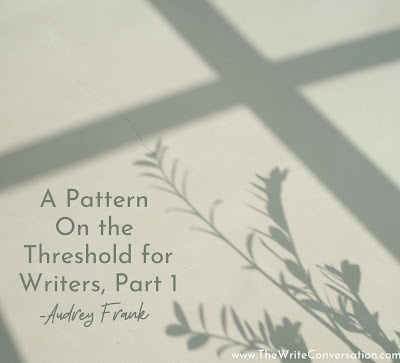
by Audrey Frank @AudreyCFrank
All Scripture quotations are NLT.
John Mark is believed to be the author of the gospel of Mark. Like many a good writer, he was a quiet, steadfast observer. His mother’s house in Jerusalem was a gathering place for the church (see Acts 12). We learn in Acts 12:12 that on the night Peter was miraculously released from prison by an angel, he returned to Mark’s family home. Mark was Peter's friend and an assistant on the earliest missionary journey of Saul and Barnabas. As he witnessed these marvelous events, Mark recorded details that still instruct us today.
In his opening chapter, Mark shows us a pattern from the life of Jesus on the eve of His public ministry. This same pattern can be seen in all who stand on the threshold of their life-work for God.
We are called away from our comfort zone, our home, to take a step of obedience before others.
One day Jesus came from Nazareth in Galilee, and John baptized him in the Jordan River (Mark 1:9).
Gospel writer Matthew notes that John the Baptist tried to talk Jesus out of being baptized by him, but Jesus replied, “It should be done, for we must carry out all that God requires” (Matthew 3:15).
Many writers are uncomfortable and intimidated about this first step, trying to talk themselves out of going public with the private message God has given. Yet it should be done, for we must carry out all God requires. As stewards of the words He provides, we must step out and make them known to those lined up along the river of our obedience, longing for hope and new life.
As we obey our Father in heaven affirms us with His love, and He does so before many witnesses.
As Jesus came up out of the water…a voice from heaven said, “You are my dearly loved Son, and you bring me great joy” (Mark 1:10a, 11).
It is a great comfort to know that when we obey the Lord He takes responsibility for our reputations. Proverbs 4:18 describes the way of the one who follows the Way of the Lord:
The way of the righteous is like the first gleam of dawn, which shines ever brighter until the full light of day.
The Lord is faithful like the rising of the dawn until it reaches the full light of day. As we take each step forward with Him, others will recognize that we walk with Him. They will see it is good, and that we are loved and bring Him great joy. Those witnesses will want to know that same love and experience for themselves the joy-bringing confidence for those who walk with Him on the Way. Before we know it, we won’t be alone. Others will join us and we will walk on with Jesus together.
Jesus’ critics stood among the witnesses that day by the river. Yet they could not stop the thundering voice of His Father’s affirmation. It won’t stop your Father from affirming you, either.
Going into the wilderness is preparation for ministry; indeed, the Spirit Himself compels us to go.
The Spirit then compelled Jesus to go into the wilderness, where he was tempted by Satan for forty days. He was out among the wild animals… (Mark 1:12-13a).
Taking that brave step to sign up for a writer’s conference, to sit before an editor or agent, to sit at your desk day after day doing the work of actually writing, courageously putting your words out there at risk of rejection, all this can feel very much like a wilderness where the wild animals dwell.
In the wilderness, we find out who we depend on for the power necessary to do what God has asked us to do.
Where are you today, dear writer?
Lord, make me aware of Your presence as I take the next brave step on the Way. Amen.
Join me next month as we explore the temptations writers face in the wilderness.
TWEETABLEA Pattern on the Threshold for Writers, Part 1 from @AudreyCFrank on @EdieMelson (Click to Tweet)
 Audrey Frank is an author, speaker, and storyteller. The stories she shares are brave and true. They give voice to those whose words are silenced by shame, the hard things in life that don’t make sense, and the losses that leave us wondering if we will survive. Audrey and her family have spent over twenty years living and working among different cultures and world views, and she has found that God’s story of redemption spans every geography and culture. He is the God of Instead, giving honor instead of shame, gladness instead of mourning, hope instead of despair. Although she has three different degrees in communication and intercultural studies, Audrey’s greatest credential is that she is known and loved by the One who made her.
Audrey Frank is an author, speaker, and storyteller. The stories she shares are brave and true. They give voice to those whose words are silenced by shame, the hard things in life that don’t make sense, and the losses that leave us wondering if we will survive. Audrey and her family have spent over twenty years living and working among different cultures and world views, and she has found that God’s story of redemption spans every geography and culture. He is the God of Instead, giving honor instead of shame, gladness instead of mourning, hope instead of despair. Although she has three different degrees in communication and intercultural studies, Audrey’s greatest credential is that she is known and loved by the One who made her.Audrey is the author of Covered Glory: The Face of Honor and Shame in the Muslim World (Harvest House Publishers), an outpouring of Audrey’s heart to introduce others to the God of Instead. Shame is not unique to the developing world, the plight of the women behind veils, young girls trafficked across borders; shame is lurking in hearts everywhere. Through powerful stories from women around the world, Covered Glory illuminates the power of the Gospel to remove shame, giving honor instead. Available at favorite booksellers: BARNES & NOBLE, BOOKS A MILLION, AMAZON.
Published on October 05, 2024 22:00
October 4, 2024
Tools That Help Us Write Through Life's Devastations
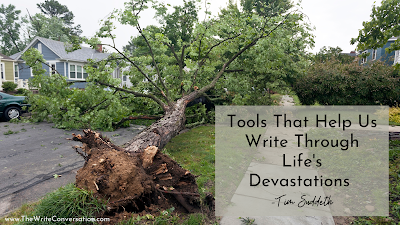
by Tim Suddeth @TimSuddeth
Devastation. We all face periods of devastation in our lives. One of Merriam-Webster definitions is to reduce to chaos, disorder, or helplessness.
Many of us are experiencing this on a whole new level after being hit by Hurricane Helene. The Big Wind Bag. The storm left unimaginable destruction in its wake over multiple states. Although, five days after the storm, we are still out of power; we were some of the fortunate ones. Four of the six homes across from us have huge trees lying on their roofs. And we are all saddened bu the stories we hear about some of our communities.
Devastation to such degree and on such a tremendous level is, thankfully, a rare event. But in a writer’s journey, one often runs into times of disappointment, rejection, or failure. And we feel helpless. The amount of devastation is different, but that doesn’t make our feelings any less real or painful. The coping skills required to get through what the storm left are the skills writers need when encountering tough times.
How To Write Through a Storm
1. Reach Out to OthersAfter the wind had passed and the rain stopped, people throughout our neighborhood came out of their dark homes. The roar of the wind was replaced by the sounds of chain saws. They walked around the neighborhood, checking out the severity of the storm, the fallen trees, and on each other. Sharing phone chargers and candles. But most importantly, people talked with other people. Somehow, that lightens the mood.
Here on The Write Conversation, we talk a lot about the need to find your group, people who are writers like you, your peeps. Other writers to share your journey. Whether your writing exceeds your expectations, or it’s like slogging through knee-deep muck, sharing the journey with other writers helps us excel.
2. Watch Out for the Envy BugNow that we have been without power for a few days, the feeling of adventure and this being an opportunity for glamping is wearing off. The app that informs us of where power is being turned on has become a place for people to, as we used to say, show themselves. ‘Why aren’t we getting power?’ ‘We should get it before them.’ “That’s not fair.”
The envy bug loves to jump on writers, too. Whether you’re a beginner or a season pro, there is always a reason to feel resentment. Maybe a friend gets a contract before you. Or you feel it’s so simple for them. Why is it so hard for me?
I don’t know if you ever get rid of the envy bug. It seems you can always find opportunities to feel resentful for someone. But envy doesn’t have to control you. Make yourself cheer for your friend. A great thing about writing is it’s a place where we can all win. NASCAR has a saying, “If you ain’t winning, you’re losing.” But that’s not how it works in writing. There are enough opportunities for all of us to win. As a better old saying goes, “A rising tide raises all ships.”
3. Don’t Give Up HopeWhatever you’re going through, it’s only for a season. Finishing a story when a character acts up, querying for an agent, waiting for the power to come back on. Someday it will be over. But it’s easy to get so caught up in the now that we can’t see past the struggle.
In Deuteronomy 31:8, Moses told the Israelites before they entered the promised land, “The Lord Himself goes before you and will be with you; He will never leave you nor forsake you. Do not be afraid; do not be discouraged.”
Hebrews 11:1 tells us, “Now faith is the assurance of things hoped for, the conviction of things not seen.” Our faith doesn’t see us through on its own, it’s Who we have our faith in.
Whether it’s disappointment in your writing desires or recovering Helene, God is the reason for our hope. In the Bible, you’ll find his promises to you to see you through.
The faith and hope we have are because of the love God has for us. Abundant love that never runs out.
I want you to know that wherever you are in the journey of writing and the journey of life, we at The Write Conversation care about you. We want all of God’s good plan for you. You are not alone. Our hearts and prayers are with you. And we know our Father is with you no matter what you are going through.
TWEETABLETools That Help Us Write Through Life's Devastations from @TimSuddeth on @EdieMelson (Click to Tweet)
 Tim Suddeth is a stay-at-home dad and butler for his wonderful, adult son with autism. He has written numerous blogs posts, short stories, and three novels waiting for publication. He is a frequent attendee at writers conferences, including the Blue Ridge Mountain Christian Writers Conference and a member of Word Weavers and ACFW. He lives near Greenville, SC where he shares a house with a bossy Shorky and three too-curious Persians. You can find him on Facebook and Twitter, as well as at www.timingreenville.com and www.openingamystery.com.
Tim Suddeth is a stay-at-home dad and butler for his wonderful, adult son with autism. He has written numerous blogs posts, short stories, and three novels waiting for publication. He is a frequent attendee at writers conferences, including the Blue Ridge Mountain Christian Writers Conference and a member of Word Weavers and ACFW. He lives near Greenville, SC where he shares a house with a bossy Shorky and three too-curious Persians. You can find him on Facebook and Twitter, as well as at www.timingreenville.com and www.openingamystery.com.
Published on October 04, 2024 22:00
October 3, 2024
Genre Expectations: Writing Gothic Horror and Standard Horror
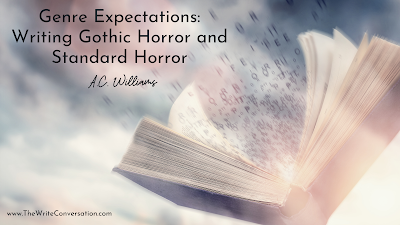
by A.C. Williams @ACW_Author
I love October. It’s my favorite month, and that’s not just because it’s my birth month. The air just feels different. At least, that’s the case in Kansas. The days start getting cooler as well, and since I work in an upstairs office with no air conditioning, I care about the temperatures!
But October is also heralded for a different reason. October is the spooky season. The time of year where ghosts and ghouls and other creatures of the night emerge from their shadowy realms and take center stage (and that’s just in the grocery stores).
While I don’t personally “celebrate” Halloween (or Carnival if you’re in Europe), I know many people who do. And like it or not, there’s a huge market for scary stories, and no list of genre expectations would be complete without taking a little trip into Horror.
For the easily frightened, don’t worry; it won’t be a long trip. And for those of you who believe you can’t learn anything from the horror genre, let me encourage you to keep reading. You never know what you might be able to use.
But first, let’s review the genres we’ve talked about so far (the link to each post is at the end of this post): Romantic Fantasy and Fantasy RomanceFantasy and Space OperaSteampunk and GaslampMagical Realism and Contemporary FantasyUrban Fantasy and Paranormal RomanceSuspense and ThrillersDystopian and ApocalypticClassic Mystery and Cozy Mystery
Like any other genre, horror has multiple subgenres, and I’m sure there are variations within each subgenre. But the general intent of Horror as a genre is to scare a reader. It is designed to leave a reader feeling unsettled and uneasy and even a little bit on edge.
If you are wanting to write a horror novel and your readers feel like they are tip-toeing through the tulips whistling a jolly little tune, you’re doing it wrong.
Maybe one day we’ll talk more about the Why behind the different genres, but for now we’re just going to focus on reader expectations, specifically between standard Horror and Gothic Horror.
So, is “gothic” just another word for “classic”? No. Actually, if you want to get into the nitty-gritty, Gothic Literature is a subgenre of Romantic Literature. Gothic-style stories are romantic stories that use dark elements and mysterious settings and sometimes supernatural creatures as plot devices.
That means, Gothic Horror novels are books designed to scare or unsettle a reader using dark, mysterious aesthetics and supernatural beings. As such, Gothic Horror includes most of the familiar scary classics, such as Dracula by Bram Stoker, The Woman in Black by Susan Hill, and Frankenstein by Mary Shelley.
Gothic horror books like these focus strongly on relationship dynamics, character emotions, and richly detailed settings. Gothic horror is going to incorporate the psychological in many ways, not so much the jump scares and physical violence readers expect in modern equivalents.
Standard horror, or modern horror, is more fast-paced and less focused on a character’s emotional or mental stability. It’s more about the moment, a surface perspective of a scary event or a person who is intent on causing your character harm. Often times, some standard horror will include physical danger or violent threats against a character.
Great modern horror examples are books such as It by Stephen King (or just about anything he’s written honestly), The Silence of the Lambs by Thomas Harris, and The Exorcist by William Peter Blatty. Some of those examples of standard horror use supernatural or paranormal beings. Some of them don’t.
I great up keeping my distance from horror books simply because I know my imagination, but when I read Frankensteinin college, I was surprised how much I loved it. Frankenstein is a brilliant story with very deep, challenging themes that still resonate with a modern audience. There’s a reason it’s a classic, guys.
But then I decided to try reading a Stephen King novel, Salem’s Lot. Again, I was shocked at how much I enjoyed it. The deep, meaningful themes were apparent early in the story, and I actually couldn’t put it down. And I wasn’t terrified either. It really read, to me, more like a suspense novel than what I had assumed a horror novel would be like.
So while Horror as a genre is absolutely designed to scare and unsettle a reader, that’s not all it is. Horror, almost like humor, is a tool authors can use to get readers to face themselves.
If you are interested in more information on how to write horror that’s more than “just a good scare,” one of the best resources I’ve found Christian Horror: On the Compatibility of a Biblical Worldview and the Horror Genre by Mike Duran.
Even if horror isn’t a genre you ever want to write, learning how masters have used it to accomplish their story goals is something every writer can benefit from. And if you do want to write horror, don’t neglect the importance of a meaningful theme under everything that goes bump in the night.
TWEETABLEGenre Expectations: Writing Gothic Horror and Standard Horror from @ACW_Author on @EdieMelson (Click to Tweet)
Don't Miss the Previous Posts in This Series 1. WRITING ROMANTIC FANTASY AND FANTASY ROMANCE
2. WRITING FANTASY AND SPACE OPERA
3. WRITING STEAMPUNK AND GASLAMP
4. WRITING MAGICAL REALISM AND CONTEMPORARY FANTASY
5. WRITING URBAN FANTASY AND PARANORMAL ROMANCE
6. WRITING SUSPENSE AND THRILLERS
7. WRITING DYSTOPIAN AND APOCALYPTIC
8. WRITING CLASSIC MYSTERY AND COZY MYSTERY 9. Writing Gothic Horror and Standard Horror
 A.C. Williams, also known as Amy C. Williams, is a coffee-drinking, sushi-eating, story-telling nerd who loves cats, country living, and all things Japanese. Author of more than 20 books, she keeps her fiction readers laughing with wildly imaginative adventures about samurai superheroes, clumsy church secretaries, and goofy malfunctioning androids; her non-fiction readers just laugh at her and the hysterical life experiences she’s survived. If that’s your cup of tea (or coffee), join the fun at www.amycwilliams.com.
A.C. Williams, also known as Amy C. Williams, is a coffee-drinking, sushi-eating, story-telling nerd who loves cats, country living, and all things Japanese. Author of more than 20 books, she keeps her fiction readers laughing with wildly imaginative adventures about samurai superheroes, clumsy church secretaries, and goofy malfunctioning androids; her non-fiction readers just laugh at her and the hysterical life experiences she’s survived. If that’s your cup of tea (or coffee), join the fun at www.amycwilliams.com.
Published on October 03, 2024 22:00
October 2, 2024
How We Use Weather in Our Writing
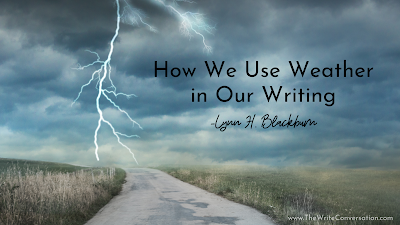
by Lynn Blackburn @LynnHBlackburn
A personal note from Lynn: Please continue to pray for all those impacted by Hurricane Helene. My brain can’t process the devastation, and my heart is broken for all who lost loved ones, homes, and livelihoods.
***
For the past few days, the weather has been front and center in my life. Hurricane Helene and her aftermath have influenced every decision I’ve made, from what I’ve purchased at the store to how I’ve spent my time to how I’ve prayed.
A few of my friends have mentioned how they fully expect some of the things that have happened to wind up in future books. And they’re probably right!
As I’ve considered this, I started thinking about how we use weather in our writing.
We generally think of weather as part of the setting, but today I want to explore the idea of weather as a character.
Weather as a Character in the Story You Write
1. Like a contentious neighbor or a gentle grandma, the weather can be as irritating as a persistent cough or as comfy as a favorite sweater.
Has it rained for five days? Is everyone tracking mud, leaves, and snow through the house? Is it so hot that when you walk outside, you immediately lose five pounds through perspiration alone?
Or does the sunset beg you to come outside and take a stroll as the wind caresses your skin? Are the leaves falling in a dance that calms your wounded heart? Does the air have just enough of a bite to be refreshing?
Whether it’s a positive or a negative, we can use the weather in our writing in the same way we would use a secondary character—to bring out the best or the worst in our hero/heroine.
2. Like an unexpected and/or unwanted visitor, the weather can thwart your characters’ plans.
You know the scene in the movies and in (too many) books where the hero and heroine are just…about…to….kiss… and the phone rings? Maybe the best friend, neighbor, or business partner has urgent news that can’t wait, and they burst onto the scene, and the mood is broken.
I’m all for the interrupted kiss myself, but what if the interruption is a clap of thunder, a lightning strike that causes an outlet to spark and then fries the modem (that happened to me this summer), or a gust of wind that blows a particularly disgusting piece of trash into the face of the would-be kisser?
The options are endless. (Imagine me giggling in a rather disturbing way as I contemplate the possibilities…or, maybe don’t!)
3. Like the best villains, the weather can put your characters’ lives in danger, threaten their future happiness, and place them in situations that force them to examine their lives. When your characters are facing a murderous fiend *and* a hurricane, you can put them into a survival spiral. This can require them to make dangerous choices that they would avoid on a sunny day.
It doesn’t have to be quite that dramatic. It could be as simple as a sunny day that convinces your heroine to go for a jog and puts her in the path of a bee…which she’s … uh-oh … allergic to.
(This could be fun…I could go on…but I won’t).
Now, a few caveats:
1. Please don’t start your book with a treatise on the weather. It can be done, and it can be done well, but in modern storytelling, it’s generally frowned upon.
2. Be careful about using the weather as a crutch in your writing. Not every difficult conversation can be avoided with a freak tornado. :)
3. Pay attention to what is reasonable weather for the location and season you’re writing about. What are the average temperatures in January or June? What about the average rainfall or snowfall?
I’m not saying you can’t push the envelope a little bit, but prior to, well, the last few days, if someone wrote a book that included a tropical storm hitting the Gulf Coast of Florida and causing massive flooding and devastation in the mountains of Western North Carolina…I would have thought that writer hadn’t done their research.
But then again, truth *is* stranger than fiction.
Grace and peace,Lynn
TWEETABLEHow We Use Weather in Our Writing from @LynnHBlackburn on @EdieMelson (Click to Tweet)
 Lynn H. Blackburn is the award-winning author of Unknown Threat, Malicious Intent, and Under Fire, as well as the Dive Team Investigations series. She loves writing swoon-worthy southern suspense because her childhood fantasy was to become a spy, but her grown-up reality is that she's a huge chicken and would have been caught on her first mission. She prefers to live vicariously through her characters by putting them into terrifying situations while she's sitting at home in her pajamas! She lives in Simpsonville, South Carolina, with her true love, Brian, and their three children. Learn more at www.lynnhblackburn.com.
Lynn H. Blackburn is the award-winning author of Unknown Threat, Malicious Intent, and Under Fire, as well as the Dive Team Investigations series. She loves writing swoon-worthy southern suspense because her childhood fantasy was to become a spy, but her grown-up reality is that she's a huge chicken and would have been caught on her first mission. She prefers to live vicariously through her characters by putting them into terrifying situations while she's sitting at home in her pajamas! She lives in Simpsonville, South Carolina, with her true love, Brian, and their three children. Learn more at www.lynnhblackburn.com.
Published on October 02, 2024 22:00
October 1, 2024
How to Add Deep POV in a Scene You're Writing

by Sarah Sally Hamer @SarahSallyHamer
Getting deeply into a character can be one of the hardest, but most necessary, ways of creating character and many people struggle with getting deep Point of View (POV) right. Deep POV is usually what the reader can't really know about a character unless it's in a thought, but there are other ways to allow our characters to express, 1) dialogue, 2) body language, 3) action, and 4) thoughts when in the POV character.
1. Dialogue, of course, is pretty obvious. When two or more characters share a conversation, we have the opportunity to really dig deep into what they think, since it's coming out of their mouth. Of course, like people, characters don't always say what they're thinking.
2. Body language can be hard to describe in a story, but there are dozens of books (writing and non-writing related) that can help. Characters, again like people, reveal a lot of secrets by the way they walk or sit or even smile.
3. Action is a tiny bit different in my mind. Yes, it's a form of body language, but it's also the movement of emotion. We move for very specific reasons—otherwise, we'd be still all the time. So, what a character is thinking makes all the difference in whether they march across a room or dance their way across.
4. Character thoughts, which are only expressed when you're in that particular character's POV, are the best way to show deep POV, simply because you're squarely in that person's head. We can't tell the reader what Joe is thinking unless we're in Joe's emotions. Emotions can express through all four at once, but we can't tell what a character is FEELING unless we're thinking their thoughts with them.
Of course, we don't need all four of them at once or even at all. Dialogue, for instance, isn't always needed in a scene. But, without one or more of the points, a character is going to be pretty flat. What we want in a story, at least at some level, is for our writing to grab the reader by their collar and drag them into the next page. The purpose of deep POV is exactly that—to give the reader enough information about a character to entice them to read more.
To see which of the four points you're using, you can take each sentence or phrase in a scene and break it down by which of the four tools you are using, and evaluate how balanced they are. Evaluating very important sections, like the first two or three pages, can immensely help us to examine our own thought process and style and see how it can be improved.
Okay, so that all being said, please don't think that you need to add volumes of information to include enough deep POV. Sometimes three or four words can fix something that seems like an overwhelming problem. A few tiny—and I want to re-emphasize the word TINY—tweaks can make all the difference.
Maybe you could add a miniscule amount of emotion. Here's a quote from one of my WIPs. It's a YA historical adventure:
Zibiah reached for the next higher bough and climbed quickly, her weight on the branches setting the almost-ripe apples swaying. She wished that she could be like Jack and ascend her beanstalk to another world where, even if a giant threatened her, it would be better than life on the ground without her best friend, Rebecca.
The emotion is strong—Rebecca has drowned in an accident and Zibiah is devastated. We need to know that she's not climbing the tree for fun and the thought behind it shows her emotional state.
Here's another small piece. Zibiah's teachers are trying to get her out of the tree but she knows she's be punished for what she's done and doesn't care that she'll be kicked out of her school:
A red haze filled Zibiah’s vision, the whooshing of her heartbeat filled her ears and, without volition, without thought, without truly meaning harm, the apple left her hand with a force fueled by blind rage.
Can you see that we're entirely in her deep POV? Do you have any doubt that she's on the edge of hysteria? And there's just a small bit, enough to let us into her mind. There's no dialogue but the other three points are as up front and center as I know how to make them. (Please excuse me using my own work but I know what I did and why and it makes it easier to explain.)
So. How do you create deep POV? Where's the most important place to put it?
TWEETABLEHow to Add Deep POV in a Scene You're Writing from @SarahSallyHamer on @EdieMelson (Click to Tweet)
 Sarah (Sally) Hamer, B.S., MLA, is a lover of books, a teacher of writers, and a believer in a good story. Most of all, she is eternally fascinated by people and how they 'tick'. She’s passionate about helping people tell their own stories and has won awards at both local and national levels, including two Golden Heart finals.
Sarah (Sally) Hamer, B.S., MLA, is a lover of books, a teacher of writers, and a believer in a good story. Most of all, she is eternally fascinated by people and how they 'tick'. She’s passionate about helping people tell their own stories and has won awards at both local and national levels, including two Golden Heart finals.A teacher of memoir, beginning and advanced creative fiction writing, and screenwriting at Louisiana State University in Shreveport for over twenty years, she also teaches online for Margie Lawson at www.margielawson.com. Sally is a free-lance editor and book coach, with many of her students and clients becoming successful, award-winning authors.
You can find her at info@mindpotential.org
Published on October 01, 2024 22:00
September 30, 2024
How to Write First Person POV: Flashback
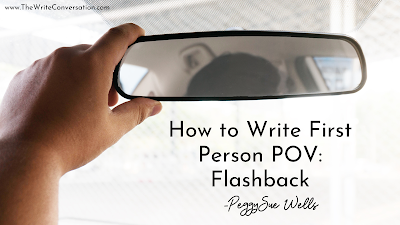
by PeggySue Wells @PeggySueWells
Point of View encompasses the narrator's position in relation to a story being told.
Who is the narrator or storyteller? Essentially, there are four categories of point of view. Within those four, a couple have subcategories.
First PersonEpistolaryFlashbackCinematicPlural
Second person
Third personLimitedObjective Omniscient
Fourth person
First Person POV is a story told from the character’s viewpoint. Characterized by the words I, Me, My, Mine, We, and Us, the story unfolds as seen solely through the eyes of the central character.
Tips for using First Person Flashback include:
Match the character’s voice as it would have been at the time of the flashback. What vocabulary did the character have at that earlier time? What was the character’s emotional state?What didn’t they know then?What did they know at that time?
Keep the flashback relevant.How does this prior scene apply to the current story? What information does the flashback give that moves the story forward?What does the flashback tell the reader about the character?
There is an art to smoothly blend a flashback into a story and seamlessly return to the present without giving the reader whiplash. One flashback in Chasing Sunrise shows the reader how our hero, Michael Northington, became a pararescueman. The flashback begins:
Standing stock-still, trailing the jet with his eyes and heart, Michael was transported back to a similar sight from his childhood in the Nebraska farmland.
On that crisp Saturday, fourteen-year-old Michael had raked the musky autumn leaves in the yard …
Several pages later, that flashback ends with:
A lizard scurried across the porch rail, bringing Michael back to the present.
Later in the story, a flashback shows the reader how Michael first came to know one of the most significant relationships of his life. The flashback begins:
The three of them had often trained together. “A tree is not a mast until it’s hewn,” Corbin would say as he ordered ever-tougher workouts. Keeping pace with Corbin reminded Michael of the day when he’d first met his boss.
On a summer afternoon ten years before, Michael’s squadron had stood in formation on the base’s grassy parade grounds…
The story returns the reader to the story’s present with:
Michael didn’t trust easily but he had grown to trust the Scotsman. Until Corbin betrayed that trust.
Now Corbin was back in Michael’s life, invading his island retreat.
Arthur Conan Doyle’s accounts of the brilliant and quirky Sherlock Holmes are written as told to the reader by Holmes’ sidekick, Dr. Watson. The mystery-solving tales are in the First Person Flashback POV as Dr. Watson looks back to recall the adventures.
“In height he was rather over six feet, and so excessively lean that he seemed to be considerably taller. His eyes were sharp and piercing, save during those intervals of torpor to which I have alluded; and his thin, hawk-like nose gave his whole expression an air of alertness and decision. His chin, too, had the prominence and squareness which mark the man of determination. His hands were invariably blotted with ink and stained with chemicals, yet he was possessed of extraordinary delicacy of touch, as I frequently had occasion to observe when I watched him manipulating his fragile philosophical instruments.”
In the film, Titanic, the heroine is introduced at the beginning as an old woman. The viewer is transported back as she remembers when she was a young woman aboard the ill-fated Titanic.
Oceans 12 is a film about an international heist. The pieces of the who-done-it puzzle come together toward the end when the viewer is given a flashback. In this montage, the characters reveal what they had been doing behind the scenes while the camera was on another character.
Flashbacks are rarely recommended in the industry for two reasons. First, flashbacks are difficult to write well. Second, when not written clearly and well, flashbacks can be confusing to the reader.
Simultaneously, First Person Flashback is another tool at the writer’s disposal. The best time to use First Person Flashback as the main point of view is when the style proves to be a compelling way to share the story and evoke emotion in the reader.
TWEETABLEHow to Write First Person POV: Flashback from @PeggySueWells on @EdieMelson (Click to Tweet)
 PeggySue Wells is the bestselling author of 40 books and collaborator of many more. Action and adventure, romantic suspense, military romance, and cozy mystery are the page-turning novels by P.S. Wells, including Homeless for the Holidays, Chasing Sunrise, The Patent, and Unnatural Cause. How to live better, easier, and simpler is the focus of her nonfiction including The Ten Best Decisions A Single Mom Can Make. Founder of SingleMomCircle.com, PeggySue coaches writing and speaks at events and conferences. When not writing, she parasails, skydives, snorkels, scuba dives, rides horses, and has taken (but not passed) pilot training. Connect with her at www.PeggySueWells.com, on Facebook at PeggySue Wells, and LinkedIn at linkedin.com/in/peggysuewells
PeggySue Wells is the bestselling author of 40 books and collaborator of many more. Action and adventure, romantic suspense, military romance, and cozy mystery are the page-turning novels by P.S. Wells, including Homeless for the Holidays, Chasing Sunrise, The Patent, and Unnatural Cause. How to live better, easier, and simpler is the focus of her nonfiction including The Ten Best Decisions A Single Mom Can Make. Founder of SingleMomCircle.com, PeggySue coaches writing and speaks at events and conferences. When not writing, she parasails, skydives, snorkels, scuba dives, rides horses, and has taken (but not passed) pilot training. Connect with her at www.PeggySueWells.com, on Facebook at PeggySue Wells, and LinkedIn at linkedin.com/in/peggysuewells
Published on September 30, 2024 22:00
September 29, 2024
Face Your Fears and Don't Let Blogging Scare You
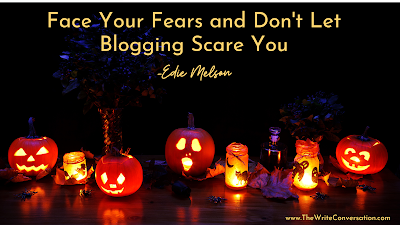
by Edie Melson @EdieMelson
It's almost October and in honor of Halloween, I just couldn't resist a tongue-in-cheek post about the scarier parts of blogging. After spending the year traveling and teaching writers about blogging, I have heard about every fear—heck, I’ve suffered from most of them. So today we’re going to look at some common fears about blogging and how to overcome them!
Remember, none of us is born knowing how to do this stuff. So let's find a way to combat our phobias together!
Overcome These 8 Common Blogging Fears
1. An Effective Title. I know that the title of a blog post has a huge impact on whether someone can find it in a Google search. Truthfully, I spend as much time coming up with a title as I do writing a post. But here’s an excellent tool—shared by the amazing Susan U. Neal: ADVANCED MARKETING INSTITUTE HEADLINE ANALYZER. The key to using this too is try for a score of 40 or higher!
2. Search Engine Optimization. Once I figured out how to do it, it was easy. But it just sounds super technical and super scary. I’ve broken down the process step-by-step here in the post, HOW TO APPLY SEO TO YOUR BLOG—ONE BLOGGER’S PROCESS to help take the scary out of this skill.
3. Blog Formatting. Formatting a blog is critical to getting post read and found. But this skill can be overwhelming, so this blog post, BLOG FORMATTING TIPS will help you figure out what you need to do to make sure it’s easy to read!
4. Sticking with a schedule. I am absolutely adamant about staying on a schedule with this site. But it's something that hasn't always been easy for me. I can tell you that keeping a schedule is something that separates the professionals from the hobbyists. Our own Katy Kauffman has this one covered in her post, MAP OUT YOUR BLOGGING CALENDAR WITH THESE 10 TIPS.
5. Finding free/copyright free images. I used to agonize over finding just the right picture to illustrate my site and NOT infringe on someone else's copyright. Now I have 2 places I use to find images. HTTP://WWW.PIXABAY.COM/ and HTTP://WWW.UNSPLASH.COM/. Both have only Creative Common License 0 images and are easy to use. They have the highest quality images and I recommend both sites without reservation.
6. Getting Comments. I used to struggle with this one. But I discovered one key was to use open-ended questions or a call to action. But knowing the solution still left me struggling. It was hard to come up with questions that were natural and encouraged conversation. In the blog post, 7 WAYS TO ENCOURAGE CONVERSATION ON YOUR BLOG, I share the basics of how to get more comments.
7. Fighting burnout. Yep, been there, done that. Blogging sounds like a good idea—and is a great way to connect with our audience. But after about 3 or 4 posts it becomes work. Life interferes, it's hard to come up with what to write about, and it feels like we're writing to an audience of zero. When this happens we've have to find the way to persevere through the hard times. For this one, I recommend the blog post, WHEN A WRITER IS STRESSED, A LIST OF WHAT NOT TO DO.
8. Inconsistent numbers. I used to think that if I was doing it right, my blog would grow—consistently. The truth is there's nothing consistent about blogging numbers. They're impacted by the seasons, the weather, even what's happening in our world. I've learned to remember that each number is represented by a person, and every single person deserves my best. I have two blog posts regarding this issue, first, BLOG NUMBERS DROPPING? And second, HOW FAST SHOULD MY BLOG GROW?
These are the things I've struggled with over my years of blogging. I'd love to now what you'd add to my list of Reasons Blogging Can Be Scary.
Be sure to share your thoughts in the comments section below.
TWEETABLEFace Your Fears & Don't Let Blogging Scare You @EdieMelson (Click to Tweet)
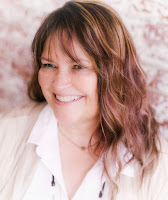 Edie Melson is a woman of faith with ink-stained fingers observing life through the lens of her camera. No matter whether she’s talking to writers, entrepreneurs, or readers, her first advice is always “Find your voice, live your story.” As an author, blogger, and speaker she’s encouraged and challenged audiences across the country and around the world. Her numerous books reflect her passion to help others develop the strength of their God-given gifts and apply them to their lives.Connect with her on her WEBSITE, through FACEBOOK, X (FORMALLY TWITTER) and on INSTAGRAM.
Edie Melson is a woman of faith with ink-stained fingers observing life through the lens of her camera. No matter whether she’s talking to writers, entrepreneurs, or readers, her first advice is always “Find your voice, live your story.” As an author, blogger, and speaker she’s encouraged and challenged audiences across the country and around the world. Her numerous books reflect her passion to help others develop the strength of their God-given gifts and apply them to their lives.Connect with her on her WEBSITE, through FACEBOOK, X (FORMALLY TWITTER) and on INSTAGRAM.
Published on September 29, 2024 22:00



